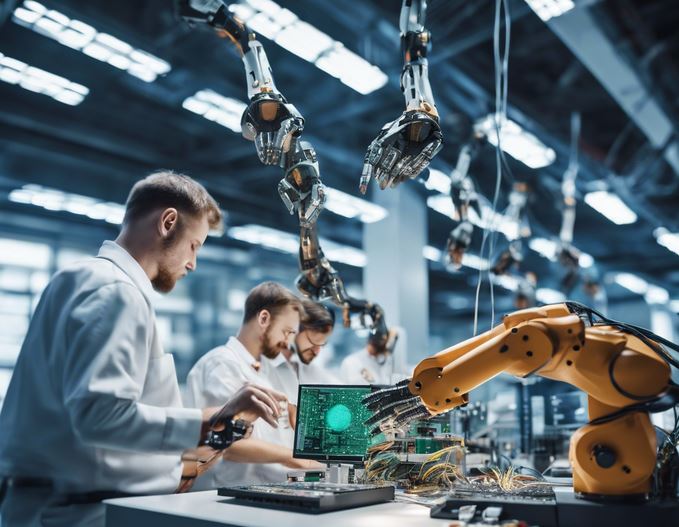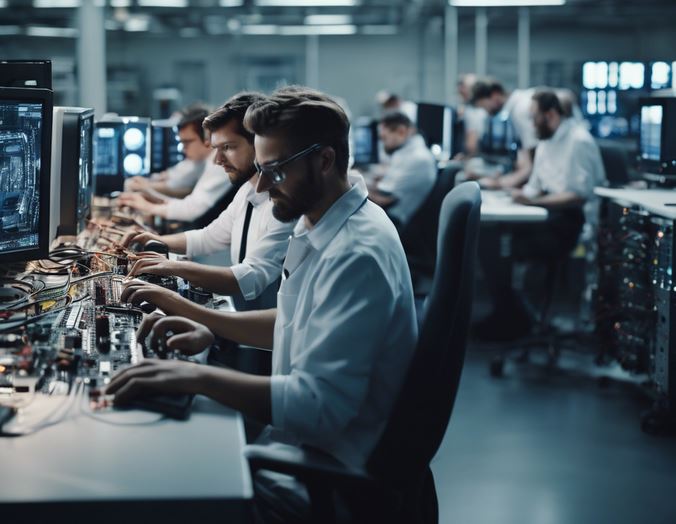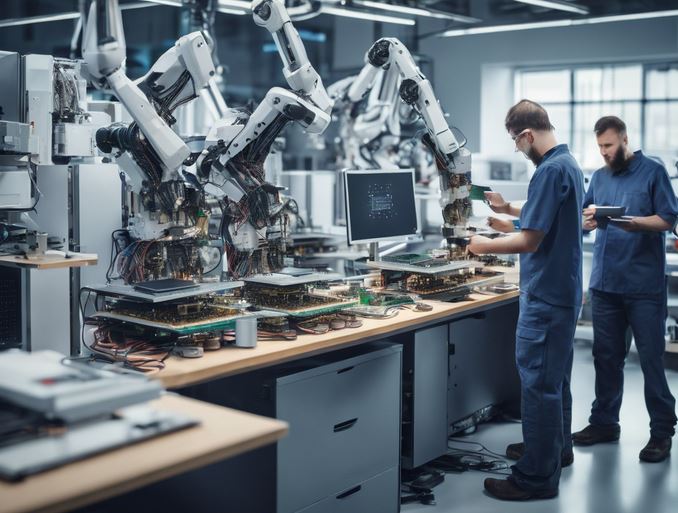FAQs
What is AI in electronics manufacturing?
AI refers to artificial intelligence, a branch of computer science concerned with creating intelligent machines capable of learning and problem-solving.
How is AI used in PCBA?
AI is used throughout the PCBA process, from design optimization and predictive maintenance to automated visual inspection and intelligent process control.
What are the benefits of AI in electronics manufacturing?
AI offers a range of benefits including increased efficiency, reduced costs, improved quality, faster time-to-market, and enhanced worker safety.
What are the challenges of implementing AI in electronics manufacturing?
Potential challenges include job displacement, high upfront investment costs, and data security concerns. However, the long-term benefits of AI often outweigh these challenges.
How can manufacturers prepare for the AI revolution in electronics manufacturing?
Manufacturers can prepare by investing in AI training for their workforce, exploring pilot programs to test AI solutions, and developing a robust cybersecurity strategy.
The Evolving Landscape of Electronics Manufacturing
The Evolving Landscape of Electronics Manufacturing The electronics manufacturing sector is foundational to our technology driven society. Products ranging from smartphones to sophisticated medical devices and industrial automation systems rely on complex electronic circuits.
At the core of these technologies is the Printed Circuit Board Assembly (PCBA), carefully assembled with numerous electronic components. Previously, making PCBAs depended greatly on manual work and highly skilled technicians.

Today, while these professionals are still crucial, Artificial Intelligence (AI) has brought significant changes by automating tasks with high accuracy. AI algorithms now significantly influence many aspects of electronics manufacturing, including design optimization, assembly, and strict quality control.
AI’s Impact on PCBA and Electronics Manufacturing AI is initiating a new phase in electronics manufacturing, where advanced capabilities significantly streamline old processes and improve outcomes. Particularly in PCBA production, AI contributes to predicting potential issues before they become costly or disrupt production. It supports real time adjustments during assembly that ensure greater product consistency and reliability.
Adopting an orchestrated approach integrating AI can remarkably expedite development cycles for new electronic products. Benefits include more precise prototypes early in the design stage which reduces overall costs respectively time taken from concept to market ready product.AI is transforming technology design and manufacturing in several key ways:
- Enhanced Design and Optimization: AI examines large amounts of data to help make smarter design choices and improve operations. It ensures components work well together and enhances PCBA (Printed Circuit Board Assembly) layouts for better thermal management and signal quality.
This method reduces mistakes and boosts the performance of devices. For example, AI can look at thermal simulations to identify potential overheating problems in a detailed PCBA layout. Engineers can use this information to optimize the placement of components and cooling methods before starting production. - Predictive Maintenance: AI acts as a proactive monitor for manufacturing equipment, keeping an eye out for possible issues before machinery fails. By evaluating sensor data and past performance of equipment, AI predicts when maintenance might be needed.
This forward thinking strategy reduces interruptions in production and maintains consistent product quality. Preventive maintenance schedules can be set upDuring periods when machines are not active, it is important to maximize the efficiency of production. - Automated Visual Inspection: AI powered vision systems carefully examine PCBs for any defects at very high speeds and with great precision. These smart tools can spot small problems such as components that are aligned properly, tiny solder defects, and even very small cracks on the board.
Traditionally, human inspectors relied on eyesight and experience, but AI systems analyze high-resolution images with far greater precision and consistency, significantly reducing the risk of human error. - Improved Supply Chain Management: AI algorithms leverage historical data and market trends to make informed decisions about supply chain management. By forecasting electronic component demand with greater accuracy, manufacturers can maintain optimal stock levels, preventing stockouts and unnecessary inventory costs.
AI can also identify potential disruptions in the supply chain, allowing manufacturers to source components from alternative suppliers and minimize production delays.
Benefits of AI in Electronics Manufacturing
AI steps in to handle the repetitive tasks that were once the domain of human workers, offering a multitude of advantages:
- Increased Efficiency: AI streamlines processes, automates repetitive tasks, and minimizes human error, leading to significant efficiency gains in production.
Repetitive tasks like component placement and soldering can be automated by AI-powered robots, freeing up human workers to focus on more complex tasks that require critical thinking and problem-solving skills. - Enhanced Quality: AI-powered inspection systems and intelligent process control ensure consistently high-quality products.
Defects are minimized, leading to a more reliable and trustworthy final product. This translates to fewer product recalls and increased customer satisfaction. - Reduced Costs: Streamlined processes, minimal waste, and fewer delays translate to lower overall manufacturing costs. AI can help manufacturers optimize resource allocation and pricing strategies.
By minimizing rework due to defects and production delays, AI helps manufacturers achieve significant cost savings. - Improved Time-to-Market: Quicker design adjustments and smoother production processes facilitated by AI result in faster product launches. This allows manufacturers to capitalize on market trends and stay ahead of the competition.
- Enhanced Worker Safety: By automating dangerous tasks like soldering, AI reduces the risk of injuries amongst workers. This fosters a safer working environment and improves overall employee well-being.

The Human-AI Collaboration
It’s important to understand that AI is not meant to replace human workers in electronics manufacturing entirely. Instead, it serves as a powerful complement, working alongside human expertise to achieve optimal results. Here’s how this collaboration unfolds:
- Domain Expertise: Human engineers and technicians continue to play a crucial role in design, process development, and overall decision-making.
Their expertise in electronics and manufacturing principles remains invaluable. AI can analyze vast amounts of data to identify trends and potential issues, but human engineers still need to interpret this data and make informed decisions. - Upskilling and Reskilling: As AI transforms the industry, there will be a need for upskilling and reskilling the existing workforce. Workers can develop new skill sets in areas like data analysis.
AI management, and working alongside intelligent machines. This will ensure a smooth transition into the AI-powered future of electronics manufacturing.

The Road Ahead
The integration of AI into electronics manufacturing represents a significant leap forward. With its ability to automate tasks, optimize processes, and ensure consistent quality.
AI offers numerous advantages for manufacturers. However, it’s crucial to acknowledge potential challenges like job displacement and the high upfront investment required for AI implementation.
- Job Displacement and Workforce Transition: While automation through AI might lead to job cuts within the electronics manufacturing sector, new opportunities are likely to arise in areas like system design, data analysis, and AI management.
Upskilling and retraining initiatives can help existing workers transition into these new roles. The focus will shift from manual dexterity to technical expertise and the ability to manage and work alongside AI systems. - High Upfront Investment: Setting up AI systems in manufacturing facilities often involves a substantial upfront investment. This can include the cost of hardware, software licenses, and the expertise needed to develop and implement AI solutions.
Despite the initial cost, the long-term benefits of AI, such as increased efficiency, reduced costs, and improved quality, often outweigh the initial expenditure. - Data Security Challenge in AI: Balancing Effectiveness with Privacy and Security. This necessitates robust cybersecurity measures to safeguard sensitive production information and intellectual property.
Manufacturers need to prioritize data security to mitigate potential risks, such as data breaches or cyberattacks.
Preparing for the AI Revolution
Manufacturers can prepare for the AI revolution in electronics manufacturing by taking proactive steps:
- Invest in AI Training: Upskilling the existing workforce in areas like data analysis, AI fundamentals, and working with intelligent machines is crucial. This allows employees to adapt to the changing landscape and contribute effectively in an AI-powered environment.
- Explore Pilot Programs: Implementing AI in a controlled setting can help manufacturers assess its effectiveness and identify potential challenges before large-scale deployment. Pilot programs can be used to test different AI solutions and refine their implementation strategies.
- Develop a Robust Cybersecurity Strategy: Data security is paramount when working with AI. Manufacturers need to establish robust cybersecurity measures to protect sensitive data, prevent unauthorized access, and ensure the integrity of AI systems.
- Prioritize Human-AI Collaboration: While AI automates tasks and optimizes processes, human expertise remains vital in design, decision-making, and overseeing AI operations. Fostering a collaborative environment where humans and AI work together will unlock the full potential of this technology.
